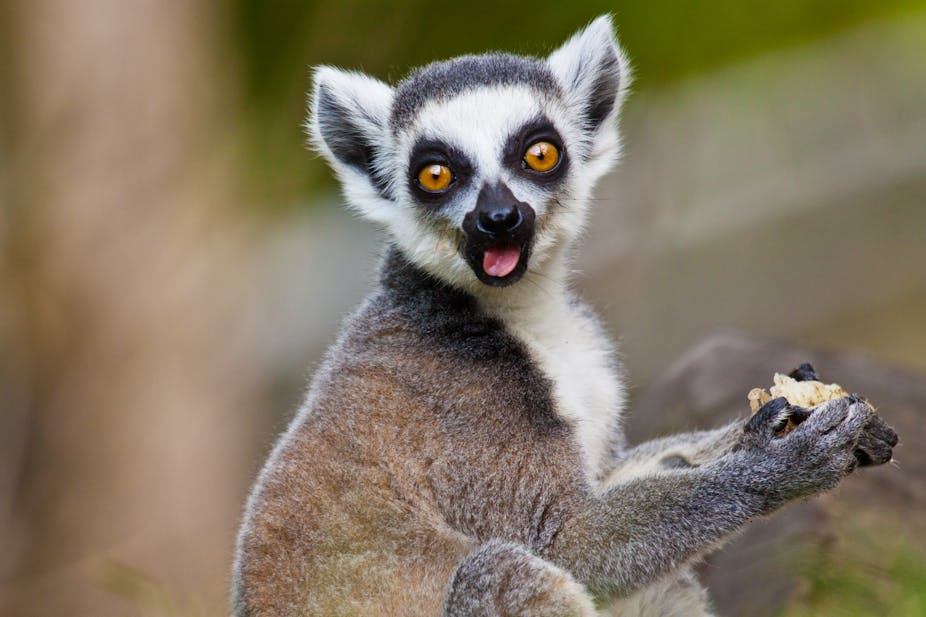It is common knowledge that the world faces an historic threat to biodiversity and natural species everywhere. This threat, caused by climate change, loss of habitats and over-exploitation – among other things – may be new. But it is not unprecedented. Extinctions have occurred throughout geological history, some of them relatively recently. A lot can be learnt from these past events to help us prevent future extinctions. And scientists are doing just that.
One example comes from Madagascar, the African island that is home to the lemur. These emblematic species occur only in Madagascar. They are of high conservation priority, and are also incredibly charismatic. In fact, Time magazine recently named them the new pop-culture star of the mammal world. They supplanted sloths, in case you were wondering. They are some of the world’s most threatened animals – more than 90% of the roughly 100 species face extinction. They need all the pop-culture cachet they can get.
Lemurs are most threatened by the loss and fragmentation of their habitats, which are mainly tropical forests. In the past 60 years nearly half of Madagascar’s forest cover has been converted for agricultural production, mining and urban development. This trend continues today.
Ghost stories
The word lemur is derived from the Latin lemures, which refers to spirits of the dead – a bit portentous given their current state. The name reflects the Malagasy word for lemur, gidro or ghost. It’s named for the eerie calls sometimes wafting through forests at dawn and dusk.
As it happens, this ghostly name is already quite fitting. Madagascar experienced a massive extinction event between 2,000 and 500 years ago that saw the disappearance of at least 17 species of lemur. Scientists debate the extent of human involvement in these extinctions, but it is well accepted that we played a major role. This time period coincides with an increase in human populations on the island, and activities like forest fragmentation and hunting certainly contributed to these extinctions.
But what was bad for Madagascar in the past may prove useful in the future. By investigating the cascading effects of historical lemur extinctions on their forest habitats, we can make informed estimates about the effects of lemur loss in the present. This can help shape conservation and management decisions for the future.

Spreading seeds
Lemurs rely on forest habitats for food and shelter, but they also play key roles in maintaining the health of the forests in which they live. The same was also true of now-extinct lemurs. For example, when lemurs eat the fruit of a tree – let’s say a species of palm tree – they can swallow seeds and eventually deposit them, in their faeces, in new growing sites.
Seed dispersal to new growing sites helps plants to establish new populations and this is incredibly important for maintaining healthy and diverse forests. In Madagascar, lemurs are especially important seed dispersers, as there are very few fruit-eating birds in comparison with tropical forests elsewhere. Protecting fruit-eating lemurs will benefit the forest ecosystems in which they live by promoting seed dispersal, and the establishment of new and diverse plant generations. And part of that will be investigating how past extinctions affected seed dispersal in Madagascar’s forests.
Scientists can infer the diet and potential seed-dispersal abilities of extinct lemur species using chemical analyses, and dental and cranial morphology. Many of the recently extinct lemur species ate fruit, and all of them were substantially larger than any lemur living today.
It turns out that losing these large animals created many orphaned trees, or tree species with seeds too big to be swallowed and dispersed by the remaining, smaller, fruit-eating lemurs found today. In the absence of their lemur dispersers, these tree species may still persist due to their long life-spans, and other uncertain dispersal mechanisms such as wind and rats. But their populations are likely in decline, and their futures in jeopardy.
Today the critically endangered black-and-white ruffed lemur is the largest living seed disperser in Madagascar. Many forest trees have seeds that are too large to be eaten by any living species besides this lemur. This foreshadows the echoed effects of extinction, and highlights the precarious balance between living lemurs and the ecosystems in which they function.
Lessons from the past
We can gain new perspectives for future conservation plans by understanding how the ghosts of lemurs past are still affecting ecosystems today. It’s important to make plans that account for these delicate inter-species relationships, as well as ones that involve local communities and incentivise alternative land-use practices to deforestation.
Many reserves and conservation organisations – the World Wildlife Fund, Madagascar Flora and Fauna Group, and Bezà Mahafaly, to name a few – are already adopting more integrative conservation strategies. Maybe, by taking a more holistic approach, we can prevent ourselves from fulfilling the prophesy of such an ephemeral name.

